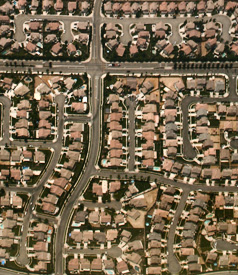Why Long Commutes Are Bad for the American Body and Mind
Suburban sprawl has long been criticized by urban scholars and intellectuals as damaging to the American mind and environment. On the psychological level, it is seen as damaging to communities, preventing the development of closer relations between residents of suburbs who spend more and more of their time commuting to jobs, and suffer from living within “subdivisions” with little in terms of civic cultural experiences.
Sprawl, simply defined, consists of the outward expansion of metropolitan areas, accompanied by the rise of communities with lower population density. These new communities (suburbs) are heavily car-reliant, and often characterized by large home lots and other expansive uses of land such as golf courses, corporate industrial parks, and large mall complexes.
Sprawling suburban subdivisions are notorious for separating residences from other aspects of community life. The farthest of the outlying metropolitan suburbs – also known as exurbs, are typically are often referred to as “bed in” communities, since they are seen as places to live, while their inhabitants commute to middle and inner ring suburbs (in proximity to major cities) for work. These exurbs are often very far from individual bread earners’ sources of occupational income, requiring commutes of between 30 to 60 minutes or longer. Exurbs have been implicated in further perpetuating metropolitan racial and economic segregation, as prosperous middle and middle upper income families flee from older “inner ring” suburbs that are experiencing increased racial integration, and move toward far off “outer ring” suburbs characterized by heavy sprawl.[1] Exurbs are merely intensifying an already-existing problem. In the case of Chicago, for example, more than 80 percent of metropolitan school districts for Cook County (the city’s major county) are already segregated – defining segregation as the existence of black or Hispanic populations that are 20 percent higher or lower than the metropolitan average.[2]
Recent empirical evidence suggests that the sprawling suburbs may be exacting a negative effect on the public in ways that were entirely predictable, but rarely discussed by national (and many local) policy leaders. This data raises serious questions about the decline of “social capital,” defined in the scholarly arena as the “social connections and the attendant norms and trust” that are vital to community-based living.[3] The Gallup polling organization reports that the “well being” of metropolitan Americans is apparently “lower among workers with long commutes.” The study, released this month, finds that “lengthy commuters are more likely to experience a range of physical and emotional conditions,” including “severe health problems,” such as neck or back pain (especially for those commuting more than 20 minutes) and higher cholesterol and larger “body mass index(es),” due, no doubt, to over-consumption of fattening fast foods. This last finding is not surprising.[4] In a day and age where a commuter can buy fries, a sandwich, and a soda for less than $3 dollars, those spending long amounts of time commuting are more likely to be tempted with such unhealthy options over healthier eating of (less available) fruits and vegetables.
Emotional effects of sprawl are felt in many ways as well. Those with longer commutes are generally less likely to “experience enjoyment for much of the previous day or to say they felt well-rested” in their daily routines. Gallup warns that significant societal changes are needed in order to combat the harmful effects of America’s sprawling social system. “The results imply that many employers may need to reevaluate their options for helping workers manage those effects, particularly in light of the costs associated with low wellbeing. Those who are hesitant to allow telecommuting, for example, may need to consider balancing the physical and emotional toll of long commutes against the social benefits of having employees together in the workplace. Employers should also recognize that it’s not just the time lost in commuting that may have adverse effects. Particularly in tough economic times, commuting expenses – whether they go to gas and parking or mass transit fees – may contribute to elevated worry levels. Helping defray those costs may help employees make the long trek to and from work with greater peace of mind.”
Proponents of “new urbanism,” in which metropolitan towns and communities are constructed so as to allow work, living, and community civics to be more closely integrated,[5] have pointed to the need to spatially (geographically) reorganize suburban and urban living in order to reduce commute times, promote public transportation, and allow more time for individuals to ensure their physical and emotional health. Integrating shopping, community civic life, and residential living within individual communities pursuing new development projects may do much – when pursued alongside the Gallup suggestions above – in promoting a healthier lifestyle for America’s increasingly exhausted work force. Such changes will represent a dramatic change, however, from current practices that increasingly isolate American suburbanites from friends, family, and themselves.
——-
End Notes:
[1] Danielle Gordon, “White Flight Taking Off in Chicago Suburbs,” Chicago Reporter, 31 August 2007, https://www.chicagoreporter.com/index.php/c/Cover_Stories/d/%E2%80%98White_Flight%E2%80%99_Taking_Off_in_Chicago_Suburbs
[2] These calculations were arrived at by the author after examining the state of Illinois’ report card documents for 2008, which provide data on the racial demographics of metropolitan schools for the Chicago land area. These data were then compared with metropolitan averages for the total white, Hispanic, and black populations for the city and its suburbs.
[3] Robert Putnam, “Tuning in, Tuning Out: The Strange Disappearance of Social Capital in America,” PS: Political Science & Politics (Vol. 38, no. 4) December 1995; also see: Robert D. Putnam, Bowling Alone: The Collapse and Revival of American Community (New York: Simon & Schuster, 2000).
[4] Steve Crabtree, “Well Being Lower Among Americans with a Longer Commute,” Gallup, 13 August 2010, https://www.gallup.com/poll/142142/Wellbeing-Lower-Among-Workers-Long-Commutes.aspx
[5] Jane Jacobs, The Death and Life of Great American Cities (New York: The Modern Library, 1993).
